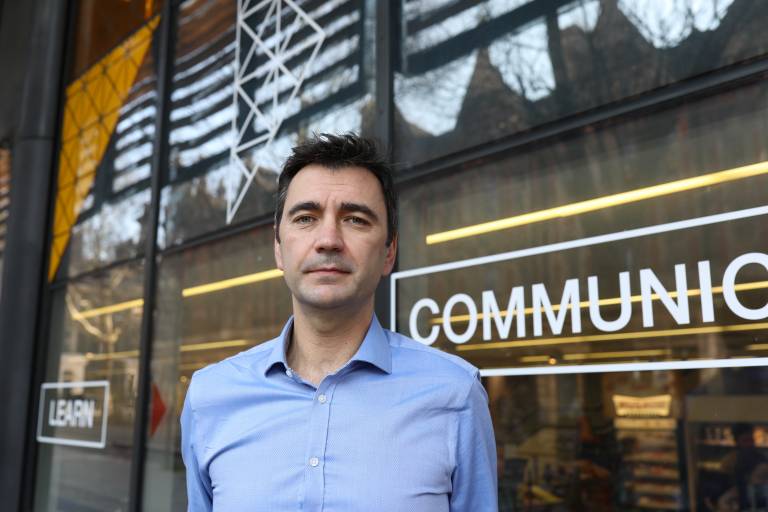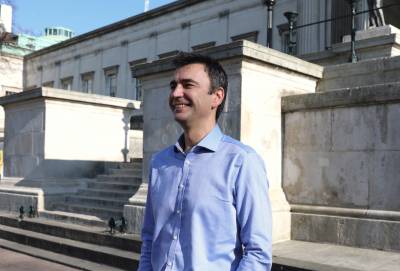Spotlight on Geoff Parker, UCL’s new Professor of Healthcare Engineering, Imaging and Enterprise
1 April 2019
“I have a magpie-like attraction to new ideas.”

Geoff Parker joins UCL today as our new Professor of Healthcare Engineering, Imaging and Enterprise. He comes from University of Manchester where he led the Quantitative Biomedical Imaging Lab (QBI Lab), focusing on the use of MRI and advanced analysis techniques to identify imaging biomarkers. His expertise includes the application of MRI methods to a wide range of diseases, including neurological conditions, lung disease, liver disease, musculoskeletal disease and cancer. He is also the founder of a University of Manchester spin-out company, Bioxydyn Limited, which provides an advanced imaging biomarkers contract research service to both academia and the pharmaceutical industry.
Professor Parker’s position in Computer Science (CMIC) holds the exciting potential for direct clinical impact, as he is co-appointed with the UCL Queen Square Institute of Neurology supported by the UCLH BRC and will be working directly within the National Hospital for Neurology and Neurosurgery.In this interview, we get to know him a bit more, find out his plans for translational activity and hear his excitement at UCL’s unique opportunities for research collaboration.
Welcome to UCL! What are you most looking forward to about being here?
I find the sheer number of talented researchers available to collaborate with very exciting. UCL has a unique breadth and depth in both fundamental imaging methods research and clinical sciences. I've already set up multiple collaborations before officially starting, so I am looking forward to hitting the ground running.

Your new role here has a translational focus, what are your hopes for translational healthcare engineering activity at UCL over the upcoming months?
From a personal perspective, I aim to capitalise on the unique opportunities for research collaborations within UCL. Specific examples include the development of new imaging methods in neuroscience, lung disease and cancer, but there are likely to be more.
More generally, I am also keep to help expand translational activity by identifying new clinical challenges and matching those to the excellent healthcare engineering activities and capabilities at UCL. I am a big fan of collaboration between institutions, as these generally benefit everyone involved. Such collaborations are essential for rapid translation of great research ideas, so I will be getting involved in as many of these as I can.
Lastly, I have a strong interest in using commercialisation of research outputs as an effective way to aid translation, so I will be looking out for ideas that have potential in this area and encouraging researchers to take advantage of this route.
How important do you think this kind of translation is to research?
My own research is highly translational, so it is of core importance to what I do. Fundamentally I see areas of clinical adoption as sources of challenges and inspiration. Achieving effective translation is then the natural end point to meeting those challenges.
You’re coming to UCL with previous experience of spinning-out your research and forming a company, Bioxydyn Limited. What is the most valuable lesson you’ve learnt from this?
The most valuable lesson is that commercialisation is one of the few paths to real translation of research into healthcare. If a healthcare technology can survive in a commercial environment then that goes a long way to demonstrating that translation is viable, as it means that what you have is valuable enough for someone to want to pay for it.
And do you have any other advice, what have been the greatest challenges and highlights of your own career so far?
A real long-term highlight of my career is being associated with two areas of MRI research that have turned into areas of massive research growth and clinical adoption - diffusion MRI and dynamic contrast-enhanced MRI. While I certainly can't claim to have invented or launched either field (far from it!) I have made substantial contributions, which is very satisfying. A current area of focus for me is a method known as oxygen-enhanced MRI, which has attractive applications in a number of disease settings. It is too soon to know if this will have similar long-term impact, but it is exciting to be at the leading edge of this emerging area.
My biggest challenge has always been to stop myself from spreading myself too thinly. I have a magpie-like attraction to new ideas and find it hard not to get involved in interesting new research directions. This has served me very well on many occasions, but it has also tended to lead to too many late nights keeping up with commitments.
The advanced imaging techniques that you work on are applied to many different disease conditions, but how does this research actually get used and impact patients?
The outputs of our research get used in a couple of ways. New imaging methods are eventually adopted for use in hospitals to improve patient diagnosis and monitoring. A good example of this is the use of MRI methods to screen for certain types of breast cancer. Additionally, new imaging methods, particularly quantitative methods, are used by drug companies to provide early, non-invasive, and sensitive readouts regarding the impact of their new drugs. A good example of this is the use of MRI methods to detect treatment effects in rheumatoid arthritis, or new methods used to detect subtle alterations in the brain's blood supply. This sort of use tends to happen at an earlier stage than clinical use.
Finally, where do you see your field being in ten years, in terms of scientific developments and advancements?
That is a genuinely difficult question to answer for such a broad area! At a very general level, the area will need to be alert to the relentless requirement for cost-effective healthcare provision, which can be challenging for a field that historically has often been associated with expensive bits of kit. There will always be a need for the provision of high-end equipment and initiatives that push boundaries, but that needs to filter through to technologies that can be deployed in the real world, ideally at scale.
Professor Geoff Parker will be sitting within CMIC on the 8th floor, MPEB UCL and can be contacted at geoff.parker@ucl.ac.uk- do make your introductions!
 Close
Close

